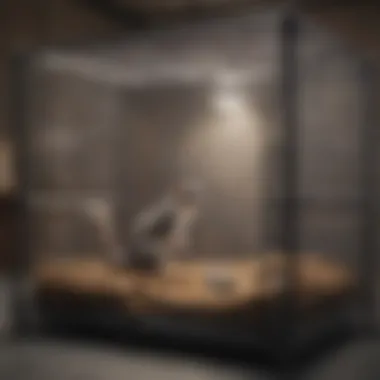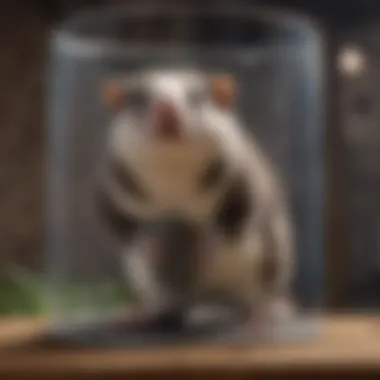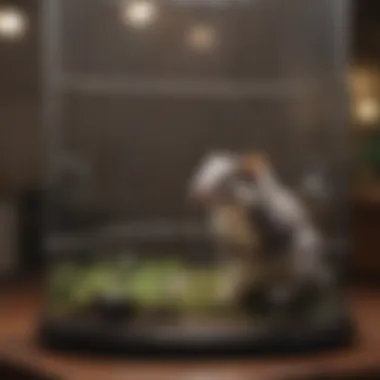Unveiling the Ultimate Selection of Sugar Glider Cages for Optimal Comfort and Well-Being


Animal Species Profile
When considering the best cages for sugar gliders, it is essential to first understand the unique characteristics of these fascinating animals. Sugar gliders, scientifically known as Petaurus breviceps, are small marsupials native to Australia, Indonesia, and Papua New Guinea. They have a distinctive appearance, with a membranous skin stretching between their front and hind legs, allowing them to glide from tree to tree in their natural habitat. These nocturnal creatures are known for their social nature and playful demeanor, often forming close bonds with their colony members.
Pet Care & Tips
When it comes to choosing the right cage for your sugar glider, several factors need to be considered to ensure their well-being and happiness. The size of the cage is crucial, providing ample space for these active animals to move around, climb, and glide. Opt for a cage made of safe materials such as powder-coated metal or stainless steel to prevent any harm to your pet. Consider the design of the cage, ensuring it has appropriate ventilation, secure locks, and easy access for cleaning and interaction. Additionally, include enrichments like branches, ropes, and hammocks to stimulate your sugar glider mentally and physically. Following these pet care tips will contribute to a comfortable and safe environment for your beloved pet.
Understanding Sugar Gliders
Introduction to Sugar Gliders
Native Habitat and Behavior
When discussing the native habitat and behavior of sugar gliders, we shed light on their origins and natural tendencies. Sugar gliders are arboreal marsupials native to Australia and New Guinea. They are nocturnal creatures with a strong bonding instinct, often found in family groups. Understanding their natural behavior helps mimic their environment in captivity to promote their physical and mental health.
Unique Characteristics
The unique characteristics of sugar gliders set them apart as captivating pets. From their gliding abilities to their omnivorous diet, sugar gliders showcase a range of interesting traits. Their ability to glide from tree to tree using their patagium, a skin membrane, is a remarkable adaptation. Additionally, their social nature and vocalizations add to their charm as pets. Acknowledging these unique features guides us in selecting appropriate cages that cater to their specific needs.
Why Choose the Right Cage?
Impact on Health and Well-being
Selecting the right cage directly impacts the health and well-being of sugar gliders. The cage size, ventilation, and cleanliness play a significant role in preventing stress-related illnesses and promoting overall vitality. Proper environmental conditions within the cage contribute to a happy and healthy sugar glider.
Promoting Natural Behaviors


Choosing the right cage design can stimulate natural behaviors in sugar gliders. Providing ample space for climbing, foraging, and exploring mimics their natural habitat, encouraging physical activity and mental stimulation. The cage layout and enrichment tools can promote exercise and social interaction, essential for the well-being of these highly social animals.
Key Factors to Consider
When delving into the realm of sugar glider care, one cannot overlook the crucial Key Factors to Consider when selecting an appropriate cage. These considerations are paramount in ensuring the well-being and contentment of these endearing creatures. Size and Space requirements, Material and Durability, as well as Accessibility and Security, all play pivotal roles in creating a conducive living environment for sugar gliders.
Size and Space Requirements
Minimum Cage Dimensions
When it comes to the Minimum Cage Dimensions for sugar gliders, precision is key. The dimensions of the cage directly impact the comfort and mobility of these agile creatures. Optimal cage dimensions provide ample space for gliders to roam, glide, and exercise, mimicking their natural habitat. A spacious environment promotes physical activity, mental stimulation, and overall well-being for sugar gliders. However, cramped spaces may lead to stress, lethargy, and health issues, underscoring the significance of adequate cage size.
Vertical vs. Horizontal Space
Choosing between Vertical and Horizontal Space allocation in a sugar glider cage warrants careful consideration. Vertical space allows gliders to climb, jump, and explore their surroundings vertically, replicating their arboreal lifestyle. On the other hand, horizontal space facilitates running, foraging, and social interactions among gliders. A balanced combination of vertical and horizontal space caters to the diverse behavioral needs of sugar gliders, fostering a dynamic and enriching living environment for these social creatures.
Material and Durability
Safe and Non-toxic Materials
Selecting Safe and Non-toxic Materials for constructing a sugar glider cage is essential to prevent potential health hazards. Sugar gliders are sensitive to chemicals and toxins, making it imperative to opt for materials that are pet-safe and non-toxic. Stainless steel, powder-coated metal, and hardwood are popular choices known for their durability and safety. These materials ensure a secure and non-toxic habitat, safeguarding the health and well-being of sugar gliders.
Easy to Clean and Maintain
The ease of cleaning and maintenance is a critical aspect when considering the Material of a sugar glider cage. Easy to Clean and Maintain materials streamline cage upkeep, minimizing the risk of bacterial growth and odors. Removable tray bottoms, washable platforms, and smooth surfaces facilitate hassle-free cleaning routines, promoting hygiene and cleanliness within the enclosure. Opting for cage materials that are resistant to staining and odor absorption simplifies upkeep and ensures a pristine living environment for sugar gliders.
Accessibility and Security
Door Design and Locking Mechanisms


The Door Design and Locking Mechanisms are integral features that determine the accessibility and security of a sugar glider cage. Secure door latches and escape-proof locks are paramount to prevent unauthorized openings and ensure the safety of gliders. Additionally, easy access for cleaning and interaction is facilitated by well-designed doors that are sturdy and reliable. Choosing cages with robust locking mechanisms and well-constructed doors guarantees a secure and accessible environment for both the sugar gliders and their caregivers.
Escape-Proof Features
Incorporating Escape-Proof Features in a sugar glider cage is indispensable to prevent accidental escapes and ensure the confined space is secure. Features such as tight wire spacing, secure lock systems, and reinforced corners mitigate the risk of gliders escaping or injuring themselves. Escape-Proof Measures offer peace of mind to owners, knowing that their beloved pets are contained safely within the enclosure. By prioritizing escape-proof design elements, the risk of untoward incidents and escape attempts is minimized, fostering a secure and comforting space for sugar gliders.
Recommended Cage Options
Recommended Cage Options section of this article sheds light on crucial aspects pertaining to selecting the best enclosure for sugar gliders. Understanding the significance of a suitable cage is paramount in ensuring the well-being and contentment of these charming creatures in captivity. Factors such as size, material, design, and features play a vital role in creating a comfortable and secure living space for sugar gliders. Exploring the realm of cage options offers insights into providing an enriching environment that promotes the physical and mental health of sugar gliders.
Enclosure Designs
Open Air Cages
Delving into the world of Open Air Cages reveals a distinctive approach to housing sugar gliders. Emphasizing on an open design, Open Air Cages provide ample ventilation and a sense of freedom for the gliders. The key characteristic of these cages lies in their spacious and unobstructed layout, allowing for natural air circulation and a closer simulation to the gliders' natural habitat. The unique feature of Open Air Cages is their ability to enhance the gliders' well-being by reducing confinement and encouraging exploration. While these cages foster a sense of openness, potential challenges may arise in maintaining appropriate temperature levels and controlling access to the environment.
Multi-level Enclosures
Exploring the concept of Multi-level Enclosures unveils a vertical dimension in sugar glider housing. The highlight of these cages is their capacity to maximize space utilization through multiple levels, offering diverse areas for movement and activity. The key characteristic of Multi-level Enclosures is their ability to cater to the gliders' climbing instincts and provide a dynamic environment for exercise and exploration. These cages stand out as a versatile choice for promoting physical engagement and mental stimulation. The unique feature of Multi-level Enclosures lies in their potential to mimic the gliders' natural arboreal behavior, thereby enriching their captive experience. Despite their benefits, considerations should be made regarding accessibility and cleaning challenges associated with multi-level structures.
Top Picks in the Market
Manufacturer A's Cage
Delving into the features of Manufacturer A's Cage unveils a craftsmanship focused on durability and functionality. The key characteristic of this cage is its robust construction using high-quality materials, ensuring longevity and safety for the inhabitants. The unique feature of Manufacturer A's Cage lies in its innovative design elements, such as removable panels for easy cleaning and accessibility. This cage stands out as a reputable choice for its reliability and practicality in meeting the needs of sugar gliders. While it offers substantial benefits in terms of security and comfort, potential drawbacks may include limited customization options and relative high cost compared to other models.
Bestseller Brand Cage
Exploring the attributes of Bestseller Brand X Cage reveals a sought-after choice among sugar glider enthusiasts. The key characteristic of this cage is its versatile design that caters to both the gliders' needs and the owners' preferences. The unique feature of Bestseller Brand X Cage is its modular components that allow for customization and expansion according to individual requirements. This cage stands out for its adaptability and ease of assembly, providing a user-friendly experience for pet owners. While it excels in versatility and aesthetics, considerations should be made regarding potential complexity in configuration and compatibility with accessories and add-ons.


Maintenance and Care Tips
When it comes to caring for sugar gliders, maintenance is crucial for their health and well-being. Proper cleaning and hygiene practices not only ensure a safe living environment but also prevent potential health issues. By following a regular maintenance routine, sugar glider owners can promote a clean and comfortable space for their pets. A clean cage contributes to the overall health of sugar gliders by minimizing the risk of bacterial infections and respiratory problems.
Cleaning and Hygiene Practices
Regular Cage Cleaning Routine
Regular cage cleaning is a fundamental aspect of maintaining a healthy environment for sugar gliders. This routine involves removing waste, replacing bedding, and wiping down surfaces to eliminate bacteria and odors. By adhering to a consistent cleaning schedule, pet owners can prevent the buildup of harmful pathogens and maintain a fresh living space for their sugar gliders.
The key characteristic of a regular cage cleaning routine is its ability to uphold cleanliness and hygiene standards. This practice ensures that sugar gliders are not exposed to contaminants that could jeopardize their health. Although time-consuming, regular cleaning is a popular choice among pet owners seeking to prioritize their pets' well-being.
Regular cage cleaning stands out for its efficacy in reducing the risk of infections and illnesses in sugar gliders. By implementing this practice, pet owners create a conducive environment that supports their pets' health and happiness.
Sanitization Methods
Sanitization methods play a vital role in maintaining a hygienic sugar glider habitat. These methods involve using pet-safe cleaning agents to disinfect the cage and eliminate germs. Sanitization helps in eradicating harmful bacteria and parasites that could pose a threat to sugar gliders' health.
The key characteristic of sanitization methods lies in their ability to kill germs and pathogens effectively. This practice is a popular choice among pet owners due to its reliable disinfection properties. By sanitizing the cage regularly, pet owners can create a safe and healthy environment for their sugar gliders.
Sanitization methods offer the advantage of thorough disinfection, ensuring that sugar gliders are protected from harmful microorganisms. By incorporating these methods into their cleaning routine, pet owners can safeguard their pets' well-being and prevent potential health concerns.
Conclusion
In delving into the realm of sugar gliders and their optimal housing, it becomes apparent that the selection of the right cage is paramount for the well-being and contentment of these charming creatures. The cage serves as the primary environment where sugar gliders spend a significant portion of their time, impacting their physical health and mental stimulation. Understanding the key factors to consider, such as size, material, design, and features, is essential in providing a safe and enriching space for sugar gliders to thrive in captivity.
Final Thoughts on Sugar Glider Cages
Importance of Quality Housing
The importance of quality housing for sugar gliders cannot be overstated, playing a crucial role in ensuring their overall welfare and happiness. Optimal housing goes beyond mere containment; it provides a secure and suitable habitat that promotes natural behaviors and physical well-being. Quality housing is characterized by sturdy construction, ample space, and accessibility features that facilitate cleaning and maintenance. By investing in a high-quality cage, sugar glider owners can create a comfortable and safe environment that mimics their natural habitat, fostering a sense of security and contentment for these small, arboreal marsupials.
Bonding with Your Pet
Bonding with sugar gliders is a rewarding experience that is significantly influenced by their living environment. The cage serves as the centerpiece of interaction between owners and their pets, influencing the quality of the bond formed. Opting for a well-designed and spacious cage enables owners to engage in enriching activities with their sugar gliders, such as placement of toys, feeding interactions, and observation of natural behaviors. A proper cage not only safeguards the sugar gliders but also fosters trust and companionship between humans and these social animals. Building a strong bond with sugar gliders transcends mere companionship; it nurtures a deep sense of mutual understanding and care, enriching the lives of both the pet and its owner.







